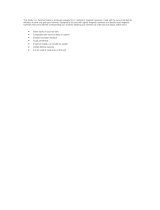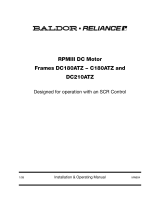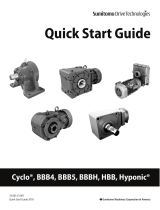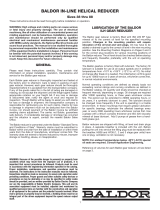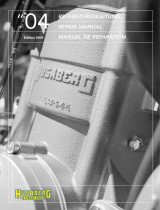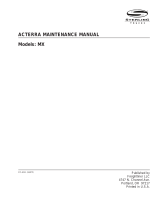Page is loading ...

1
WARNING: To ensure the drive is not unexpectedly
started, turn off and lock-out or tag power source before
proceeding. Failure to observe these precautions could
result in bodily injury.
WARNING: All products over 25 kg (55 lbs) are noted on the
shipping package. Proper lifting practices are required for
these products.
WARNING: Because of the possible danger to person(s)
or property from accidents which may result from the
improper use of products, it is important that correct
procedures be followed. Products must be used in
accordance with the engineering information specified
in the catalog. Proper installation, maintenance and
operation procedures must be observed. The instructions
in the instruction manuals must be followed. Inspections
should be made as necessary to assure safe operation
under prevailing conditions. Proper guards and other
suitable safety devices or procedures as may be desirable
or as may be specified in safety codes should be provided,
and are neither provided by ABB nor are the responsibility
of ABB. This unit and its associated equipment must be
installed, adjusted and maintained by qualified personnel
who are familiar with the construction and operation of
all equipment in the system and the potential hazards
involved. When risk to persons or property may be
involved, a holding device must be an integral part of the
driven equipment beyond the speed reducer output shaft.
Instruction Manual DODGE
®
TORQUE-ARM™ Speed Reducers
Taper Bushed WSCXT 115 & 125
These instructions must be read thoroughly before installation or operation. This instruction manual was accurate at the time of
printing. Please see baldor.com for updated instruction manuals.
Note! The manufacturer of these products, Baldor Electric Company, became ABB Motors and Mechanical Inc. on March
1, 2018. Nameplates, Declaration of Conformity and other collateral material may contain the company name of Baldor
Electric Company and the brand names of Baldor-Dodge and Baldor-Reliance until such time as all materials have been
updated to reflect our new corporate identity.
INSTALLATION
1. Use eyebolts to lift reducer.
2. Determine the running positions of the reducer. (See Fig. 1)
NOTE: The reducer is supplied with either 4 or 7 plugs;
4 around the sides for horizontal installations and 1
on each face for vertical installations. These plugs
must be arranged relative to the running positions as
follows:
Horizontal Installations—Install the magnetic drain plug
in the hole closest to the bottom of the reducer. Install lter/
breather in topmost hole. Of the 3 remaining plugs on the
sides of the reducer, the lowest one is the minimum oil level
plug.
Vertical Installations—Install the ller/ventilation plug in
the hole provided in the top face of the reducer housing.
Use the hole in the bottom face for the magnetic drain plug.
Of the 5 remaining holes on the sides of the reducer, use
a plug in the upper housing half for the minimum oil level
plug.
B
B
P
D
L
L
D
B
P
L
L
P
P
B
B
D
D
HORIZONTAL APPLICATIONS ▲
A-POSITION B-POSITION
C-POSITION D-POSITION
VERTICAL MOUNT
E POSITION
B
L
P
D
B
L
P
D
F POSITION
B = BREATHER D = DRAIN L = LEVEL P = PLUG
Figure 2 - Mounting Positions
The running position of the reducer in a horizontal application
is not limited to the four positions shown in Figure 1. However,
if running position is over 20º either way from sketches, the oil
level plug cannot be safely used to check the oil level, unless
during the checking the torque arm is disconnected and the
reducer is swung to within 20º in positions “B” and “D” or 5º in
positions “A” and “C” of the positions shown in Figure 1.
Because of the many possible positions of the reducer, it may
be necessary or desirable to make special adapations using the
lubrication tting holes furnished along with other standard pipe
ttings, stand pipes and oil level gages as required.
3. Mount reducer on driven shaft as follows:
For Taper Bushed: Mount reducer on driven shaft per
instructions for tapered bushings.
4. Install sheave on input shaft as close to reducer as
practical. (See Fig. 2.)
Keep
Close
Keep
Close
Input
Shaft
Driven
Shaft
Figure 2 - Installation of Sheave

2
5. Install motor and V-belt drive so belt will approximately be
at right angles to the center line between driven and input
shaft. (See Fig. 3.) This will permit tightening the V-belt
with the torque arm screw. (See Fig. 4.) Make sure that
there is sufcient take-up in the turnbuckle for belt tension
adjustment when using V-belt drive
Right Angle
or may vary
30˚ in tension
20˚ in compression
V– Belt
Drive
V– Belt Drive may
be located to the
right if desired
Figure 3 - Installation of Motor and V-Belt Drive
Right Angle
or may vary
30˚ in tension
20˚ in compression
Torque Arm and
Belt Take–up
Torque Arm may be
located to the right
if desired
Figure 4 - Tighten Belt with Torque Arm Screw
6. Install torque arm and adaptor plates using the long reducer
bolts. The bolts may be shifted to any of the holes on the
input end of the reducer. Fig. 3
7. Install torque arm fulcrum on a rigid support so that the
torque arm will be approximately at right angles to the
center line through the driven shaft and the torque arm
anchor
CAUTION: Unit is shipped without oil. Add proper amount
of recommended lubricant before operating. Failure to
observe this precaution could result in damage to, or
destruction of, the equipment.
8. Fill gear reducer with recommended lubricant.
LUBRICATION
Because reducer is shipped without oil, it is necessary to add
the proper amount of oil before running. Use a high grade
petroleum-base, rust and oxidation inhibited (R&O) gear oil – see
tables. Follow instructions on reducer nameplate, warning tags
and in the installation manual.
Under average industrial operating conditions, the lubricant
should be changed every 2500 hours of operation or every 6
months, whichever occurs rst. Drain reducer and ush with
kerosene, clean magnetic drain plug and rell to proper level
with new lubricant.
CAUTION: Extreme pressure (EP) lubricants are not
recommended for average operating conditions. Failure to
observe these precautions could result in bodily injury.
CAUTION: Too much oil will cause overheating and too little
will result in gear failure. Check oil level regularly. Failure to
observe this precaution could result in bodily injury.
Under extreme operating conditions, such as rapid rise and fall
of temperature, dust, dirt, chemical particles, chemical fumes, or
oil sump temperatures above 200ºF., the oil should be changed
every 1 to 3 months depending on severity of conditions.
CAUTION: Do not use EP oils or oils containing slippery
additives such as graphite or molybdenum disulphide in
the reducer when backstop is used. These additives will
destroy sprag action.
Table 1 - Oil Levels
Reducer
Size
Volume of Oil Required to Fill Reducer to Oil Level Plug
① Position A ① Position B ① Position C ① Position D ① Position E ① Position F
Fluid
Ounces
(Approx)
②
Quarts
(Approx)
Liters
(Approx)
Fluid
Ounces
(Approx)
②
Quantis
(Approx)
Liters
(Approx)
Fluid
Ounces
(Approx)
②
Quantis
(Approx)
Liters
(Approx)
Fluid
Ounces
(Approx)
②
Quantis
(Approx)
Liters
(Approx)
Fluid
Ounces
(Approx)
②
Quantis
(Approx)
Liters
(Approx)
Fluid
Ounces
(Approx)
②
Quantis
(Approx)
Liters
(Approx)
WSCX T115
WSCX T125
16 1/2 .48 16 1/2 .48 20 5/8 .59 24 3/4 .71 32 1 .95 32 1 .95
① Refer to Fig. 1 on page 2 for mounting positions.
② U.S. Measure: 1 quart = 32 fluid ounces = .94646 liters.
Note: If reducer position is to vary from those shown in Figure 1, either more or less oil may be required. Consult Mechanical Power Transmission Support.

3
MOTOR MOUNTS
The motor mount must be installed on output end of reducer as
shown in Figure 5.
Remove two housing bolts on output end of reducer. Place the
motor mount in position and install the longer housing bolts
supplied with the motor mount. Tighten bolts to torque specied
in Table 6.
Install motor, drive sheave and drive sheave so that driven
sheave is as close to the reducer housing as practical. Install
V-belt and tension with the four adjusting screws provided on
T-A M motor mount. Check all bolts to see that they are securely
tightened.
Figure 5 - Motor Mount on Output End of Reducer
NOTE: Belt guard removed for photographic purposes.
WARNING: Do not operate if belt guard is not in place.
REPLACEMENT OF PARTS
Using tools normally found in a maintenance department, a
Dodge Torque-Arm Speed Reducer can be disassembled and
reassembled by careful attention to the instructions of following.
Cleanliness is very important to prevent the introduction of dirt
into the bearings and other parts of the reducer. A tank of clean
solvent, an arbor press, and equipment for heating bearings and
gears, should be available for shrinking these parts on shafts.
The oil seals are of the rubbing type and considerable care
should be used during disassembly and reassembly to avoid
damage to the surface which the seals rub on.
The keyseat in the input shaft as well as any sharp edges on the
output hub should be covered with scotch tape or paper before
disassembly or reassembly. Also be careful to remove any burrs
or nicks on surfaces of the input shaft or output hub before
disassembly or reassembly.
ORDERING PARTS:
When ordering parts for reducer specify reducer size number,
reducer serial number, part name, part number and quantity. It
is strongly recommended that when a pinion or gear is replaced,
the mating gear or pinion be replaced also.
If the large gear on the output hub must be replaced it is
recommended that an output hub assembly of a gear assembled
on a hub be ordered to secure undamaged surfaces on the
output hub where the oil seals rub.
However, if it is desired to use the old output hub, press the gear
and bearing off and examine the rubbing surface under the oil
seal carefully for possible scratching or other damage resulting
from the pressing operation. To prevent oil leakage at the shaft
oil seals the smooth surface of the output hub must not be
damaged.
If any parts must be pressed from a shaft or from the output
hub, this should be done before ordering parts to make sure that
none of the bearings or other parts are damaged in removal. Do
not press against outer race of any bearing. Because old shaft
oil seals may be damaged in disassembly it is advisable to order
replacements for these parts.
Table 2 - Minimum Oil Recommendations to Average Operating Conditions
Lubrication Recommendations – ISO Grades for Ambient Temperatures of
15º to 60º
Lubrication Recommendations – ISO Grades for Ambient Temperatures of
50º to 125º
Output
RPM
Reducer Size Output
RPM
Reducer Size
1 2 3 4 5 6 7 8 9 10 12 13 14 15
1 2 3 4 5 6 7 8 9 10 12 13 14 15
301-400 220 220 150 150 150 150 150 150 150 150 150 150 150 150 301-
400
320 320 220 220 220 220 220 220 220 220 220 220 220 220
201-300 220 220 150 150 150 150 150 150 150 150 150 150 150 150 201-
300
320 320 220 220 220 220 220 220 220 220 220 220 220 220
151-200 220 220 150 150 150 150 150 150 150 150 150 150 150 150 151-200 320 320 220 220 220 220 220 220 220 220 220 220 220 220
126-150 220 220 220 150 150 150 150 150 150 150 150 150 150 150 126-150 320 320 320 220 220 220 220 220 220 220 220 220 220 220
101-125 220 220 220 220 150 150 150 150 150 150 150 150 150 150 101-125 320 320 320 320 220 220 220 220 220 220 220 220 220 220
81-100 220 220 220 220 220 150 150 150 150 150 150 150 150 150 81-100 320 320 320 320 320 220 220 220 220 220 220 220 220 220
41-80 220 220 220 220 220 150 150 150 150 150 150 150 150 150 41-80 320 320 320 320 320 220 220 220 220 220 220 220 220 220
11-40 220 220 220 220 220 220 220 220 220 220 15 150 150 150 11-40 320 320 320 320 320 320 320 320 320 320 220 220 220 220
1-10 220 220 220 220 220 220 220 220 220 220 220 220 220 220 1-10 320 320 320 320 320 320 320 320 320 320 320 320 320 320
Below – 23ºF call application engineering.
20ºF to -22ºF use Mobil SHC 627.
Above 125ºF use Mobil SHC 634.
NOTES:
• Pour point of lubricant selected should be at least 10ºF lower than expected minimum ambient starting temperature.
• Extreme pressure (EP) lubricants are not recommended for average operating conditions
• Special lubricants may be required for food and drug industry applications where contact with the product being manufactured may occur. Consult a lubrication
manufacturer's representative for recommendation.
• Do not use oils containing slippery additives such as graphite or molybdenum disulphide in the reducer when backstop is used. These additives will destroy sprag action.

4
REMOVING REDUCER FROM SHAFT: TAPER
BUSHED—
1. Remove bushing screws.
2. Place the screws in the threaded holes provided in the
bushing anges. Tighten the screws alternately and
evenly until the bushings are free on the shaft. For ease of
tightening screws, make sure screw threads and threaded
holes in bushing anges are clean.
3. Remove the outside bushing, the reducer and then the
inboard bushing.
DISASSEMBLY:
1. Position reducer on its side and remove all bolts. Gently tap
the output hub and input shaft with a soft hammer (rawhide,
not a lead hammer) to separate the housing halves. Open
housing evenly to prevent damage to the parts inside.
2. Lift shaft, gear, and bearing assemblies from housing.
3. Remove seals from housing.
REASSEMBLY:
1. Output Hub Assembly: Heat gear to 325ºF to 350ºF to shrink
onto hub. Heat bearings to 270ºF to 290ºF to shrink onto hub.
Any injury to the hub surfaces where the oil seals rub will
cause leakage making it necessary to use a new hub.
2. Countershaft Assembly: Shaft and pinion are integral. Press
gear and bearings on shaft. Press against inner (not outer)
race of bearings.
3. Input Shaft Assembly: Shaft and pinion are integral. Press
bearings on shaft. Press against inner (not outer) race of
bearings.
4. Drive the two dowel pins into place in the right hand housing
half. Position right half of housing (as shown in drawing) on
blocks to allow clearance for protruding end of output hub.
5. Mesh output hub and countershaft together and place in
housing half. Place input shaft assembly in housing half. Tap
lightly with a soft hammer (rawhide, not lead hammer) until
bearings are properly seated in housing. Make sure that the
snap rings on the O.D. of the bearings come into contact with
the housing.
6. Clean housing ange surfaces on both halves, making sure
not to nick or scratch ange face. Place a new bead of gasket
eliminator on ange face and spread evenly over the entire
ange leaving no bare spots.
7. Place output hub bearing cup in other housing half. Make
sure cup is properly seated in housing. Place housing half in
position over dowel pins and tap with a soft hammer (rawhide,
not lead hammer) until housing halves are together. Install
housing bolts and tighten evenly. The nal wrench torque for
housing bolts is 360 lb.-ins.
8. Install the output hub seal carrier and the shims removed at
disassembly. Tighten carrier cap screws while rotating the
output hub to make sure the bearings do not bind. If the
bearings start to bind, add more shims. Torque the carrier
bolts to the value shown in table 3. Attach an indicator to the
housing and set the gage on the top end of the output hub.
Insert a pry bar under the other end of the hub and force it
upward. The axial end play of the output hub will be given by
the indicator reading. Add or remove shim stock to attain a
reading of from .001” to .003”. Remove seal carrier and place
a 1/8” diameter bead of Dow Corning RTV732 sealant on the
face around the I.D. of the last shim (sealant is to be between
shim and reducer housing). Reinstall output hub seal carrier
and tighten carrier screws to torque shown in Table 6.
9. Install oil seals. Extreme care must be observed when
installing seals on input shaft and output hub to avoid
contact with any sharp edges. This danger of damage and
consequent oil leakage can be decreased by covering all
sharp edges with adhesive tape or paper before installing
seals. Chamfer or deburr housing bore if end of bore is sharp
or rough. Fill cavity between lips of seal with grease. Seals
should be pressed or tapped evenly into place with a soft
hammer (rawhide, not lead hammer) applying force only
on the outer edge of the seals. A slight oil leakage may be
evident at the seals during initial running in, but will disappear
unless seals have been damaged.
Table 3 - Manufacturer’s Part Number For
Replacement Output Hub Bearings
TORQUE-ARM
Reducer
Drive
Size
Output Hub Bearing
DODGE Part Number
Cone Cup
WSCXT 115
WSCXT 125
402246 (JLM506849) 403149 (JLM506810)
Table 4 – Manufacturers’ Part Numbers For
Replacement Countershaft Bearings
TORQUE-ARM
Reducer
Drive
Size
Countershaft Bearing
Input Side
Countershaft Bearing
Adapter Side
DODGE
Part No.
Part No.
DODGE
Part No.
Part No.
WSCXT 115
WSCXT 125
424006 304SG 424006 304SG
Table 5 – Manufacturers’ Part Numbers For
Replacement Input Shaft Bearings
TORQUE-
ARM Reducer
Drive
Size
Input Shaft Bearing
Input Side
Input Shaft Bearing
Adapter Side
DODGE
Part No.
Part No.
DODGE
Part No.
Part No.
WSCXT 115
WSCXT 125
424112 205SG 424111 204MG
Table 6 – Bolt Tightening Torque Values
TORQUE-ARM
Reducer
Drive
Size
Housing
Bolts
(in.-lbs.)
Adapter
Bolts
(in.-lbs.)
Shaft
Retainer
Bolt
(in.-lbs.)
Output
Hub
Seal
Carrier
Bolts
(in.-lbs.)
WSCXT 115
WSCXT 125
360 360 1800 200

5
Replacement Parts WSCXT 115 & 125

6
Replacement Parts WSCXT 115 & 125
Reference Description No. Req’d.
WSCXT115 & WSCXT125
Part No.
3
4
6
①
HOUSING
Air Vent
Housing Bolt
Lockwasher
Washer
1
⑦
⑦
1
351225
A55233
411418
419 011
419092
10
12
16
18
20
22
24
Hex Nut
Dowel Pin
Pipe Plug
Magnetic Drain Plug
Countershaft Bearing Cover – Input Side
Countershaft Bearing Cover – Adapter Side Input
Shaft Bearing Cover – Adapter Side
⑦
2
5
1
1
1
1
407087
420092
430031
430060
242224
242224
361062
32 Input Shaft
Input Shaft Key
15:1 Ratio
25:1 Ratio
1
1
241302
241200
②
34*
36*
38*
Input Shaft Seal
Input Shaft Bearing – Input Side
Input Shaft Bearing – Adapter Side
1
1
1
1
443008
241457
424112
424111
42
44*
46*
COUNTERSHAFT
AS S EMBLY⑧
③ Countershaft and Pinion
③ First Reduction
Gear
③ Gear Key
15:1 Ratio
25:1 Ratio
15:1 Ratio
25:1 Ratio
1
1
1
1
1
1
392090
392091
241216
241170
241171
241309
48*
50*
Countershaft Bearing—Input Side ④
Countershaft Bearing—Adapter Side ④
1
1
424006
424006
54*
56*
58*
60*
OUTPUT HUB ASSEMBLY②
③ Output Hub
③ Output Hub Gear
③ Output Hub Gear Key
③ Snap Ring
1
1
1
1
1
391029
241233
241007
241217
421013
62
64
66
68*
70*
72*
Output Hub Seal Carrier
Carrier Screw
Lockwasher
Output Hub Seal
Output Hub Bearing – Cone ④
Output Hub Bearing – Cup ④
1
6
6
2
2
2
351114
4114 0 5
419010
351111
402246
403149
74*
①
①
①
①
Output Hub Shim Pack
.002" Thick
.005" Thick
.010" Thick
.025" Thick
1 Set ⑤
⑥
⑥
⑥
⑥
391056
427424
427425
427426
427427
75
76
77
Bushing Back-Up Plate
Retainer Ring
Adapter, Housing Bolts
2
2
2
241266
421111
411420
80
82
84
86
TORQUE ARM ASSEMBLY②
③ Rod End
③ Hex Nut
③ Turnbuckle
③ Extension
1
1
1
1
1
241097
241245
407093
241246
241247
88
90
92
94
③ L.H. Hex Nut
③ Fulcrum
③ Fulcrum Screw
③ Hex Nut
1
1
1
1
407242
241249
4114 5 6
407091
96
98
100
102
104
106
ADAPTER ASSEMBLY②
③ R.H. Adapter Plate
③ L.H. Adapter Plate
③ Adapter Bushing
③ Adapter Bolt
③ Lockwasher
③ Hex Nut
1
1
1
1
1
1
1
259151
241242
241241
242243
411412
419 011
407067
①Not shown on drawing.
② Includes parts listed immediately below. Housing Assembly also includes two-piece housing and adapter.
③These parts make up the assemblies under which they are listed. Assembly also includes two-piece
housing.
④ For manufacturer’s part number see tables 3, 4 and 5 on page 5.
⑤ One set consists of one each of the shims listed immediately below.
⑥ See last paragraph under “ORDERING PARTS.”
⑦ 6 required for SCXT1 Series.

7
OIL VISCOSITY EQUIVALENCY CHART
2000
1000
800
600
500
400
300
200
100
80
60
50
40
30
20
10
8
6
5
4
3
2
70
60
50
40
30
20
10
8
5
4
9
7
6
1500
1000
680
460
320
220
150
100
68
8A
8
7
6
5
4
3
2
85W
250
140
90
80W
46
32
22
15
10
7
5
1
75W
3
2
300
200
150
100
80
70
60
50
40
35
32
400
500
600
800
1000
1500
2000
3000
4000
5000
6000
8000
10,000
cSt/
40°C 100°C
cSt/ ISO
VG
AGMA
GRADES
GRADES
GEAR OILS
SUS/
100°F
SUS/
210°F
SAE
KINEMATIC
VISCOSITIES
SAYBOLT
VISCOSITIES
200
300
100
90
80
70
60
55
50
45
40
VISCOSITIES CAN BE
RELATED HORIZONTALLY
ONLY.
VISCOSITIES BASED ON
96 VI SINGLE GRADE
OILS.
ISO ARE SPECIFIED AT
40°C.
AGMA ARE SPECIFIED AT
40°C.
SAE 75W, 80W, AND 85W
SPECIFIED AT LOW
TEMPERATURE. EQUIVALENT
VISCOSITIES FOR 100°F
AND 200°F ARE SHOWN.
SAE 90 TO 250 SPECIFIED
AT 100°C.

—
ABB Motors and Mechanical Inc.
5711 R. S. Boreham Jr. Street
Fort Smith, AR 72901
Ph: 1.479.646.4711
Mechanical Power Transmission Support
Ph: 1.864.297.4800
new.abb.com/mechanical-power-transmission
baldor.com
© ABB Motors and Mechanical Inc.
MN1677 (Replaces 499938)
*1677-0918*
All Rights Reserved. Printed in USA.
09/18 Printshop 200
/
